Grunge
| Grunge | |
|---|---|
| Stylistic origins | |
| Cultural origins | Mid-1980s, Seattle, Washington, United States |
| Typical instruments | |
| Derivative forms | |
| Regional scenes | |
| Washington state | |
| Other topics | |
Grunge (sometimes referred to as the Seattle sound) is a subgenre of alternative rock that emerged during the mid-1980s in the American state of Washington, particularly in Seattle. The early grunge movement revolved around Seattle's independent record label Sub Pop, but by the early 1990s its popularity had spread, with grunge acts in California and other parts of the U.S. building strong followings and signing major record deals.
Grunge became commercially successful in the first half of the 1990s, due mainly to the release of Nirvana's Nevermind, Pearl Jam's Ten, Soundgarden's Superunknown, Alice in Chains' Dirt, and Stone Temple Pilots' Core. The success of these bands boosted the popularity of alternative rock and made grunge the most popular form of rock music at the time.[1] Although most grunge bands had disbanded or faded from view by the late 1990s, their influence continues to affect modern rock music.
Grunge fuses elements of punk rock and heavy metal, such as the distorted electric guitar used in both genres, although some bands performed with more emphasis on one or the other. Lyrics are typically angst-filled, often addressing themes such as social alienation, apathy, confinement, and a desire for freedom.
A number of factors contributed to grunge's decline in prominence. During the mid-late 1990s, many grunge bands broke up or became less visible. Nirvana's Kurt Cobain, labeled by Time as "the John Lennon of the swinging Northwest", appeared unusually tortured by success and struggled with an addiction to heroin before he committed suicide at the age of 27 in 1994.
Origin of the term
Although writer Paul Rambali used "grunge" in a 1978 NME article to describe mainstream guitar rock,[2] Mark Arm, the vocalist for the Seattle band Green River—and later Mudhoney—is generally credited as being the first to use the term grunge to describe this genre of music. Arm first used the term in 1981, when he wrote a letter under his given name Mark McLaughlin to the Seattle zine Desperate Times, criticizing his own band Mr. Epp and the Calculations as "Pure grunge! Pure noise! Pure shit!".[3] Clark Humphrey, contributor to Desperate Times, cites this as the earliest use of the term to refer to a Seattle band, and mentions that Bruce Pavitt of Sub Pop popularized the term as a musical label in 1987–88, using it on several occasions to describe Green River.[4]
Arm said years later, "Obviously, I didn't make grunge up. I got it from someone else. The term was already being thrown around in Australia in the mid-'80s to describe bands like King Snake Roost, The Scientists, Salamander Jim, and Beasts of Bourbon."[5] Arm used grunge as a descriptive term rather than a genre term, but it eventually came to describe the punk/metal hybrid sound of the Seattle music scene.[6]
Some bands associated with the genre, such as Soundgarden, Pearl Jam and Alice in Chains, have not been receptive to the label, preferring instead to be referred to as "rock and roll" bands.[7][8][9]
Characteristics
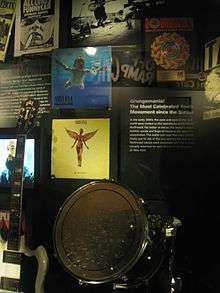
Musical style
Grunge is generally characterized by a sludgy guitar sound with a "thick midrange" and rolled-off treble tone and a high level of distortion and fuzz, typically created with small stompbox pedals, with some guitarists chaining several fuzz pedals together and plugging them into a tube amplifier.[10] The use of pedals by grunge guitarists was a move away from the expensive, studio-grade rackmount effects units used in other rock genres. Grunge guitarists played loud, with Kurt Cobain's early guitar sound coming from an unusual set-up of four 800 watt PA system power amplifiers. Guitar feedback effects were used. Grunge guitarists were influenced by the raw, primitive sound of punk, and they favored "...energy and lack of finesse over technique and precision"; key guitar influences included the Sex Pistols, The Dead Boys, Neil Young[11] (Rust Never Sleeps, side two), The Replacements, Husker Du, Black Flag and The Melvins.[12] Grunge guitarists often downtuned their instruments for a lower, heavier sound.[10] Grunge guitarists "flatly rejected" the virtuoso "shredding" guitar solos that had become the centerpiece of heavy metal songs, instead opting for melodic, blues-inspired solos - focusing "on the song, not the guitar solo"[13] - with Jerry Cantrell of Alice in Chains stating that solos should be to serve the song, rather than to show off a guitarist's technical skill.[14] In place of the strutting guitar heroes of metal, grunge had "guitar anti-heroes" like Cobain, who showed little interest in mastering the instrument.[12]
Grunge fuses elements of punk rock (especifically hardcore punk) and heavy metal, although some bands performed with more emphasis on one or the other. The music shares with punk a raw sound and similar lyrical concerns.[1] However, it also involves much slower tempos, dissonant harmonies, and more complex instrumentation—which is reminiscent of heavy metal. Some individuals associated with the development of grunge, including Sub Pop producer Jack Endino and the Melvins, explained grunge's incorporation of heavy rock influences such as Kiss as "musical provocation". Grunge artists considered these bands "cheesy" but nonetheless enjoyed them; Buzz Osborne of the Melvins described it as an attempt to see what ridiculous things bands could do and get away with.[15] In the early 1990s, Nirvana's signature "stop-start" song format became a genre convention.[1] Allmusic calls grunge a "hybrid of heavy metal and punk".[1] Although keyboards are generally not used in grunge, Seattle band Gorilla created controversy by breaking the "guitars only" approach and using a 1960s-style Vox organ in their group.[16]
According to The Atlantic, the four most influential grunge singers were: Alice in Chains' Layne Staley, who was called the "most memorable voice" of the genre for his "ability to project power and vulnerability", Nirvana's Kurt Cobain, who could both scream and sing melodically in the same song like John Lennon, Soundgarden's Chris Cornell, who "wailed and hit high notes" like Robert Plant, and Pearl Jam's Eddie Vedder, who "combined a Jim Morrison-style natural baritone range with other punk and rock influences."[17]
Lyrics
Grunge lyrics are typically angst-filled, and anguished, often addressing themes such as social alienation, apathy, confinement, and a desire for freedom. A number of factors influenced the focus on such subject matter. Many grunge musicians displayed a general disenchantment with the state of society, as well as a discomfort with social prejudices. Such themes bear similarities to those addressed by punk rock musicians.[1] In 1992, music critic Simon Reynolds said that "there's a feeling of burnout in the culture at large. Kids are depressed about the future".[18] The topics of grunge lyrics–"broken homes, drug addiction and self-loathing" contrasted sharply to the glam metal lyrics of Poison, which described "life in the fast lane".[19]
Concerts
Grunge concerts were known for being straightforward, high-energy performances. Grunge bands rejected the complex and high budget presentations of many musical genres, including the use of complex light arrays, pyrotechnics, and other visual effects unrelated to playing the music. Stage acting and "onstage theatrics" were generally avoided.[19] Instead the bands presented themselves as no different from minor local bands. Jack Endino said in the 1996 documentary Hype! that Seattle bands were inconsistent live performers, since their primary objective was not to be entertainers, but simply to "rock out".[15] One of the philosophies of the grunge scene was authenticity. Dave Rimmer writes that with the revival of punk ideals of stripped-down music in the early 1990s, "for Cobain, and lots of kids like him, rock & roll...threw down a dare: Can you be pure enough, day after day, year after year, to prove your authenticity, to live up to the music ... And if you can't, can you live with being a poseur, a phony, a sellout?"[20]
Clothing
Clothing commonly worn by grunge musicians in Washington consisted of thrift store items and the typical outdoor clothing (most notably flannel shirts) of the region, as well as a generally unkempt appearance and long hair.[19] Seattle and Aberdeen, Washington were logging towns and hence, the lumberjack attire was a common sight in the thrift stores for the low prices that musicians could afford.[21] Grunge fashion consisted of ripped jeans, mom jeans, Doc Martens, combat boots, band T-shirts, oversized knit sweaters, long and droopy skirts, ripped tights, Birkenstocks, hiking boots,[22][23][24] and eco-friendly clothing made from recycled textiles or fair trade organic cotton.[25]
“Grunge also became an anti-consumerist movement where the less you spent on clothes, the more ‘coolness’ you had.”[26] The style did not evolve out of a conscious attempt to create an appealing fashion; music journalist Charles R. Cross said, "[Nirvana frontman] Kurt Cobain was just too lazy to shampoo", and Sub Pop's Jonathan Poneman said, "This [clothing] is cheap, it's durable, and it's kind of timeless. It also runs against the grain of the whole flashy aesthetic that existed in the 80s."[18] Grunge fashion was very much an anti-fashion response and a non-conformist move against the “manufactured image”,[27] often pushing musicians to dress in authentic ways and to not glamorize themselves.
At the same time, Sub-Pop utilized the ‘grunge look’ in their marketing of their bands. In an interview with VH1, photographer Charles Peterson commented that members from grunge band Tad “were given blue collar identities that weren’t entirely earned. Bruce (Pavitt) really got him to dress up in flannel and a real chain saw and really play up this image of a mountain man and it worked.”[28]
Grunge music hit mainstream in early ‘90s with Soundgarden, Alice and Chains, and Nirvana being signed to major record labels. Grunge fashion began to break into mainstream fashion and in mid-1992 for both sexes and peaked in late 1993 and early 1994.[22][29][30] As it picked up momentum, the grunge tag was being used by shops selling expensive flannelette shirts in an effort to cash in on the trend.[26] Ironically, the non-conformist look suddenly became a mainstream trend. In the fashion world, Marc Jacobs presented a show for Perry Ellis in 1992, featuring grunge-inspired clothing mixed up with high-end fabrics. For Jacobs, he found inspiration in the ‘realism’ of streetwear and mixed it up with the luxury of fashion by sending models down in beanies, floral dresses and silk flannel shirts.[31] Unfortunately, this did not sit well with the brand owners and Jacobs was dismissed. Other designers like Anna Sui, also drew inspiration from grunge during that Spring Summer 1993 season.[27]
In the same year, Vogue did a spread called “Grunge & Glory” with fashion photographer Steven Miesel who shot supermodels Naomi Campbell and Kristen McMenamy in a savanna landscape wearing grunge-styled clothing. This shoot made McMenamy the perfect face for grunge, having had her eyebrows shaved and her hair cropped short in the shoot. In later years, designers like Christian Lacroix, Donna Karen and Karl Lagerfeld interpreted the influence into their looks.[31]
In 1993, James Truman, editor of Details, said: “to me the thing about grunge is it’s not anti-fashion, it’s unfashion. Punk was anti-fashion. It made a statement. Grunge is about not making a statement, which is why it’s crazy for it to become a fashion statement.”[32] The unkempt fashion sense defined the look of the “slacker generation”, who “skipped school, smoked pot, smoked cigarettes and listened to music” hoping to be a rock star one day.[28]
Vogue stated in 2014 that "Cobain pulled liberally from both ends of a woman’s and a man’s wardrobe, and his Seattle thrift-store look ran the gamut of masculine lumberjack workwear and 40s-by-way-of-70s feminine dresses. It was completely counter to the shellacked, flashy aesthetic of the 1980s in every way. In disheveled jeans and floral frocks, he softened the tough exterior of the archetypal rebel from the inside out, and set the ball in motion for a radical, millennial idea of androgyny."[33] Cobain's way of dressing "was the antithesis of the macho American man", because he "...made it cooler to look slouchy and loose, no matter if you were a boy or a girl."[33] Music and culture writer Julianne Escobedo Shepherd wrote that with Cobain's style of dress “Not only did he make it okay to be a freak, he made it desirable."[33]
Even though the grunge movement died down in 1994 after the death of Kurt Cobain, designers have continued to draw inspiration from the movement from time to time. Grunge appeared as a trend again in 2008 and for Fall/Winter 2013, Hedi Slimane at Saint Laurent brought back grunge to the runway. With Courtney Love as his muse for the collection, she reportedly loved the collection. "No offense to MJ [Marc Jacobs] but he never got it right," Courtney said. "This is what it really was. Hedi knows his shit. He got it accurate, and MJ and Anna [Sui] did not.”[34] Both Cobain and Love apparently burnt the Perry Ellis collection they received from Marc Jacobs back in 1993.[35]
In 2016, grunge inspired an upscale "reinvention" by A$AP Rocky, Rihanna and Kanye West.[36] However, “dressing grunge is no longer a badge of authenticity, though: the signifiers of rebellion (Dr Martens boots, plaid shirts) are omnipotent on the high street”, says Lynette Nylander, deputy editor of i-D magazine.[36]
Graphic design
Regarding graphic design and image, a common feature of grunge bands was the use of lo-fi and deliberately unconventional album covers, for example presenting intentionally murky or miscolored photography, collage or distressed lettering. This was already a common feature of punk rock design, but could be extended in the grunge period due to the increasing use of computers for desktop publishing and digital image processing. The style was sometimes called 'grunge typography' when used outside music.[37][38][39] A famous example of 'grunge'-style experimental design was Ray Gun magazine, art directed by David Carson.[40][41]
History
Roots, predecessors and influences

Grunge's sound partly resulted from Seattle's isolation from other music scenes. As Sub Pop's Jonathan Poneman noted, "Seattle was a perfect example of a secondary city with an active music scene that was completely ignored by an American media fixated on Los Angeles and New York."[42] Mark Arm claimed that the isolation meant, "this one corner of the map was being really inbred and ripping off each other's ideas".[43] Grunge evolved from the local punk rock scene, and was inspired by bands such as The Fartz, The U-Men, 10 Minute Warning, The Accüsed, and the Fastbacks.[15] Additionally, the slow, heavy, and sludgy style of the Melvins was a significant influence on the grunge sound.[44]
Outside the Pacific Northwest, a number of artists and music scenes influenced grunge. Noise rock bands such as Scratch Acid and the Butthole Surfers influenced Nirvana.[19] Alternative rock bands from the Northeastern United States, including Sonic Youth, Pixies, and Dinosaur Jr., are important influences on the genre. Through their patronage of Seattle bands, Sonic Youth "inadvertently nurtured" the grunge scene, and reinforced the fiercely independent attitudes of its musicians.[45] The influence of Pixies on Nirvana was noted by Kurt Cobain, who commented in a Rolling Stone interview, "I connected with that band so heavily that I should have been in that band—or at least a Pixies cover band. We used their sense of dynamics, being soft and quiet and then loud and hard."[46] In August 1997, in an interview with Guitar World, Dave Grohl said: "From Kurt, Krist and I liking the Knack, Bay City Rollers, Beatles and Abba just as much as we liked Flipper and Black Flag...You listen to any Pixies record and it's all over there. Or even Black Sabbath's "War Pigs"-it's there: the power of the dynamic. We just sort of abused it with pop songs and got sick with it."[47]
Aside from the genre's punk and alternative rock roots, many grunge bands were equally influenced by heavy metal of the early 1970s. Clinton Heylin, author of Babylon's Burning: From Punk to Grunge, cited Black Sabbath as "perhaps the most ubiquitous pre-punk influence on the northwest scene".[48] Black Sabbath played a role in shaping the grunge sound, through their own records and the records they inspired.[49] Musicologist Bob Gulla asserted that Black Sabbath's sound "shows up in virtually all of grunge's most popular bands, including Nirvana, Soundgarden, and Alice in Chains".[50] The influence of Led Zeppelin is also evident, particularly in the work of Soundgarden, whom Q magazine noted were "in thrall to '70s rock, but contemptuous of the genre's overt sexism and machismo".[51] Jon Wiederhorn of Guitar World wrote: "So what exactly is grunge?...Picture a supergroup made up of Creedence Clearwater Revival, Black Sabbath and the Stooges, and you're pretty close."[52]
The Los Angeles hardcore punk band Black Flag's 1984 record My War, on which the band combined heavy metal with their traditional sound, made a strong impact in Seattle. Mudhoney's Steve Turner commented, "A lot of other people around the country hated the fact that Black Flag slowed down...but up here it was really great...we were like 'Yay!' They were weird and fucked-up sounding."[53] Turner explained grunge's integration of metal influences, noting, "Hard rock and metal was never that much of an enemy of punk like it was for other scenes. Here, it was like, 'There's only twenty people here, you can't really find a group to hate.'" Bands began to mix metal and punk in the Seattle music scene around 1984, with much of the credit for this fusion going to The U-Men.[54]
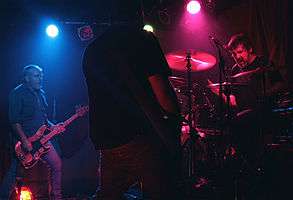
The raw, distorted and feedback-intensive sound of some noise rock bands had an influence on grunge. Among them are Wisconsin's Killdozer, and most notably San Francisco's Flipper, a band known for its slowed-down and murky "noise punk". The Butthole Surfers' mix of punk, heavy metal and noise rock was a major influence, particularly on the early work of Soundgarden.[55] Several Australian bands, including The Scientists, Cosmic Psychos and feedtime, are cited as precursors to grunge, their music influencing the Seattle scene through the college radio broadcasts of Sub Pop founder Jonathan Poneman and members of Mudhoney.[56][57]
After Neil Young played a few concerts with Pearl Jam and recorded the album Mirror Ball with them, some members of the media gave him the title "Godfather of Grunge". This was grounded not only in his work with his band Crazy Horse and his regular use of distorted guitar—most notably on the album Rust Never Sleeps—but also his dress and persona.[58] A similarly influential yet often overlooked album is Neurotica by Redd Kross, about which Jonathan Poneman said, "Neurotica was a life changer for me and for a lot of people in the Seattle music community."[59]
Early development (1980s)
A seminal release in the development of grunge was the Deep Six compilation, released by C/Z Records in 1986. The record featured multiple tracks by six bands: Green River, Soundgarden, Melvins, Malfunkshun, Skin Yard, and The U-Men. For many of them it was their first appearance on record. The artists had "a mostly heavy, aggressive sound that melded the slower tempos of heavy metal with the intensity of hardcore". As Jack Endino recalled, "People just said, 'Well, what kind of music is this? This isn't metal, it's not punk, What is it?' [...] People went 'Eureka! These bands all have something in common.'"[53]
Later that year Bruce Pavitt released the Sub Pop 100 compilation and Green River's Dry As a Bone EP as part of his new label, Sub Pop. An early Sub Pop catalog described the Green River EP as "ultra-loose GRUNGE that destroyed the morals of a generation".[60] Sub Pop's Bruce Pavitt and Jonathan Poneman, inspired by other regional music scenes in music history, worked to ensure that their label projected a "Seattle sound", reinforced by a similar style of production and album packaging. While music writer Michael Azerrad acknowledged that early grunge bands like Mudhoney, Soundgarden, and Tad had disparate sounds, he noted "to the objective observer, there were some distinct similarities."[61]
Early grunge concerts were sparsely attended (many by fewer than a dozen people) but Sub Pop photographer Charles Peterson's pictures helped create the impression that such concerts were major events.[62] Mudhoney, which was formed by former members of Green River, served as the flagship band of Sub Pop during their entire time with the label and spearheaded the Seattle grunge movement.[63] Other record labels in the Pacific Northwest that helped promote grunge included C/Z Records, Estrus Records, EMpTy Records and PopLlama Records.[15]
Grunge attracted media attention in the United Kingdom after Pavitt and Poneman asked journalist Everett True from the British magazine Melody Maker to write an article on the local music scene. This exposure helped to make grunge known outside of the local area during the late 1980s and drew more people to local shows.[15] The appeal of grunge to the music press was that it "promised the return to a notion of a regional, authorial vision for American rock".[64] Grunge's popularity in the underground music scene was such that bands began to move to Seattle and approximate the look and sound of the original grunge bands. Mudhoney's Steve Turner said, "It was really bad. Pretend bands were popping up here, things weren't coming from where we were coming from."[65] As a reaction, many grunge bands diversified their sound, with Nirvana and Tad in particular creating more melodic songs.[66] Dawn Anderson of the Seattle fanzine Backlash recalled that by 1990 many locals had tired of the hype surrounding the Seattle scene and hoped that media exposure had dissipated.[15]
Mainstream success (early–mid 1990s)
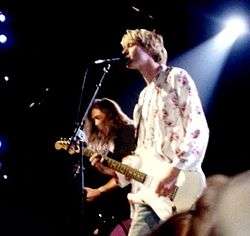
Grunge bands had made inroads to the musical mainstream in the late 1980s. Soundgarden was the first grunge band to sign to a major label when they joined the roster of A&M Records in 1989. Soundgarden, along with other major label signings Alice in Chains and Screaming Trees, performed "okay" with their initial major label releases, according to Jack Endino.[15] Nirvana, originally from Aberdeen, Washington, was also courted by major labels, while releasing its first album Bleach in 1989. Nirvana got signed by Geffen Records in 1990. In September 1991, Nirvana released its major label debut, Nevermind. The album was at best hoped to be a minor success on par with Sonic Youth's Goo, which Geffen had released a year earlier.[67] It was the release of the album's first single "Smells Like Teen Spirit" that "marked the instigation of the grunge music phenomenon". Due to constant airplay of the song's music video on MTV, Nevermind was selling 400,000 copies a week by Christmas 1991.[68] In January 1992, Nevermind replaced pop superstar Michael Jackson's Dangerous at number one on the Billboard 200.[69] Nevermind was certified diamond by the Recording Industry Association of America (RIAA) in 1999.[70]
The success of Nevermind surprised the music industry. Nevermind not only popularized grunge, but also established "the cultural and commercial viability of alternative rock in general."[71] Michael Azerrad asserted that Nevermind symbolized "a sea-change in rock music" in which the glam metal that had dominated rock music at that time fell out of favor in the face of music that was perceived as authentic and culturally relevant.[72] Grunge made it possible for genres thought to be of a niche audience, no matter how radical, to prove their marketability and be co-opted by the mainstream, cementing the formation of an individualist, fragmented culture.[73] Other grunge bands subsequently replicated Nirvana's success. Pearl Jam, which featured former Mother Love Bone members Jeff Ament and Stone Gossard, had released its debut album Ten in August 1991, a month before Nevermind, but album sales only picked up a year later. By the second half of 1992 Ten had become a breakthrough success, being certified gold and reaching number two on the Billboard charts.[74] Ten by Pearl Jam was certified 13x platinum by the RIAA.[75]
Soundgarden's album Badmotorfinger and Alice in Chains' Dirt, along with Temple of the Dog, a collaboration featuring members of Pearl Jam and Soundgarden, were also among the 100 top selling albums of 1992.[76] The popular breakthrough of these grunge bands prompted Rolling Stone to nickname Seattle "the new Liverpool".[18] Major record labels signed most of the prominent grunge bands in Seattle, while a second influx of bands moved to the city in hopes of success.[77] The grunge scene was the backdrop in the 1992 Cameron Crowe film Singles. There were several small roles, performances, and cameos in the film by popular Seattle grunge bands including Pearl Jam, Soundgarden, and Alice in Chains. Filmed in and around Seattle in 1991, the film was not released until 1992 during the height of grunge popularity.[18]
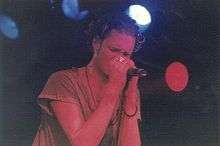
The popularity of grunge resulted in a large interest in the Seattle music scene's perceived cultural traits. While the Seattle music scene in the late 1980s and early 1990s in actuality consisted of various styles and genres of music, its representation in the media "served to depict Seattle as a music 'community' in which the focus was upon the ongoing exploration of one musical idiom, namely grunge".[78] The fashion industry marketed "grunge fashion" to consumers, charging premium prices for items such as knit ski hats and plaid shirts. Critics asserted that advertising was co-opting elements of grunge and turning it into a fad. Entertainment Weekly commented in a 1993 article, "There hasn't been this kind of exploitation of a subculture since the media discovered hippies in the '60s".[79] The New York Times compared the "grunging of America" to the mass-marketing of punk rock, disco, and hip hop in previous years.[18] Ironically the New York Times was tricked into printing a fake list of slang terms that were supposedly used in the grunge scene; often referred to as the grunge speak hoax. This media hype surrounding grunge was documented in the 1996 documentary Hype!.[15]
A backlash against grunge began to develop in Seattle; in late 1992 Jonathan Poneman said that in the city, "All things grunge are treated with the utmost cynicism and amusement [. . .] Because the whole thing is a fabricated movement and always has been."[18] Many grunge artists were uncomfortable with their success and the resulting attention it brought. Nirvana's Kurt Cobain told Michael Azerrad, "Famous is the last thing I wanted to be."[80] Pearl Jam also felt the burden of success, with much of the attention falling on frontman Eddie Vedder.[81]
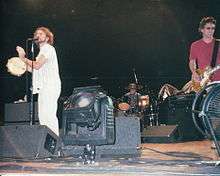
Nirvana's follow-up album In Utero (1993) featured an intentionally abrasive album that Nirvana bassist Krist Novoselic described as a "wild aggressive sound, a true alternative record"[82] Nevertheless, upon its release in September 1993 In Utero topped the Billboard charts.[83] In 1996, In Utero was certified 5x platinum by the RIAA.[84] Pearl Jam also continued to perform well commercially with its second album, Vs. (1993). The album sold a record 950,378 copies in its first week of release, topped the Billboard charts, and outperformed all other entries in the top ten that week combined.[85] In 1993, the grunge band Candlebox released their self-titled album, which was certified 4x platinum by the RIAA.[86] The album's songs "You" and "Far Behind" reached the Billboard Hot 100 chart; "You" peaked at number 78 on the chart and "Far Behind" peaked at number 18 on the chart.[87] In February 1994, Alice in Chains' EP, Jar of Flies peaked at number 1 on the Billboard 200 album chart.[88] Soundgarden's album Superunknown, which was also released in 1994, peaked at number 1 on the Billboard 200 chart,[89] and was certified 5x platinum by the RIAA.[90] In 1995, Alice in Chains' self-titled album became their second number 1 album on the Billboard 200,[88] and was certified 2x platinum.[91]
At the height of grunge's commercial success in the early 1990s, the commercial success of grunge put record labels on a nationwide search for undiscovered talent to promote. This included San Diego, California-based Stone Temple Pilots,[92] Texas-based Tripping Daisy[1][93] and Toadies,[94][95][96] Paw,[97] Chicago-based Veruca Salt,[97] and Australian band Silverchair, bands whose early work continues to be identified broadly (if not in Seattle itself) as "grunge". In 2014, Paste ranked Veruca Salt's "All Hail Me" #39 and Silverchair's "Tomorrow" #45 on their list of the 50 best grunge songs of all time.[97] Loudwire named Stone Temple Pilots one of the ten best grunge bands of all time.[92]

During this period, acts promoted as "grunge" that were not from Seattle were often panned by critics, who accused them of being bandwagon-jumpers. Stone Temple Pilots in particular fell victim to this. In a January 1994 Rolling Stone poll, Stone Temple Pilots was simultaneously voted "Best New Band" by Rolling Stone's readers and "Worst New Band" by the magazine's music critics, highlighting the disparity between critics and fans.[98] Stone Temple Pilots became very popular; their album Core was certified 8x platinum by RIAA[99] and their album Purple was certified 6x platinum by the RIAA.[100] The British band Bush released their debut album Sixteen Stone in 1994.[101] Described as grunge,[102][103][101][104] the album was certified 6x platinum by the RIAA.[105] The band's second album Razorblade Suitcase, which was released in 1996 and peaked at number 1 on the Billboard 200,[106] was certified 3x platinum by the RIAA.[107] In a review of Razorblade Suitcase, Rolling Stone criticized the album and called Bush "the most successful and shameless mimics of Nirvana's music".[108] In the book Fargo Rock City: A Heavy Metal Odyssey in Rural North Dakota, Chuck Klosterman wrote, "Bush was a good band who just happened to signal the beginning of the end; ultimately, they would became the grunge Warrant".[102] In the book Accidental Revolution: The Story of Grunge, Kyle Anderson wrote:
"The twelve songs on Sixteen Stone sound exactly like what grunge is supposed to sound like, while the whole point of grunge was that it didn't really sound like anything, including itself. Just consider how many different bands and styles of music have been shoved under the "grunge" header in this discography alone, and you realize that grunge is probably the most ill-defined genre of music in history."[109]
Decline of mainstream popularity (mid–late 1990s)
A number of factors contributed to grunge's decline in prominence. During the latter half of the 1990s, grunge was supplanted by post-grunge, which remained commercially viable into the start of the 21st century. These artists were seen as lacking the underground roots of grunge and were largely influenced by what grunge had become, namely "a wildly popular form of inward-looking, serious-minded hard rock". Post-grunge was a more commercially viable genre that tempered the distorted guitars of grunge with polished, radio-ready production.[110][111] Although the bands Bush[112][113][114] and Candlebox[115] have been categorized as grunge, both bands have been largely categorized as post-grunge, too.[111] Bush and Candlebox became popular after 1992.[111] Tim Grierson of About.com wrote about bands such as Bush and Candlebox, writing:
"Perhaps not surprisingly, because these bands seemed to be merely ripping off a trendy sound, critics dismissed them as bandwagon-jumpers. Tellingly, these bands were labeled almost pejoratively as “post-grunge,” suggesting that rather than being a musical movement in their own right, they were just a calculated, cynical response to a legitimate stylistic shift in rock music."[110]
Other bands categorized as post-grunge that emerged when Bush and Candlebox emerged include Collective Soul[110] and Live.[116] Post-grunge still was popular in the late 1990s and early 2000s with newer bands such as Creed, Nickelback, 3 Doors Down and Puddle of Mudd.[110] These post-grunge artists were criticized for their commercialized sound as well as their "worldview built around the comforts of community and romantic relationships", as opposed to grunge's lyrical exploration of "troubling issues such as suicide, societal hypocrisy and drug addiction."[110]
Conversely, another rock genre, Britpop, emerged in part as a reaction against the dominance of grunge in the United Kingdom. In contrast to the dourness of grunge, Britpop was defined by "youthful exuberance and desire for recognition".[117] Britpop artists were vocal about their disdain for grunge. In a 1993 NME interview, Damon Albarn of Britpop band Blur agreed with interviewer John Harris' assertion that Blur was an "anti-grunge band", and said, "Well, that's good. If punk was about getting rid of hippies, then I'm getting rid of grunge".[118] Noel Gallagher of Oasis, while a fan of Nirvana, wrote music that refuted the pessimistic nature of grunge. Gallagher noted in 2006 that the 1994 Oasis single "Live Forever" "was written in the middle of grunge and all that, and I remember Nirvana had a tune called 'I Hate Myself and I Want to Die,' and I was like...'Well, I'm not fucking having that.' As much as I fucking like him [Cobain] and all that shit, I'm not having that. I can't have people like that coming over here, on smack, fucking saying that they hate themselves and they wanna die. That's fucking rubbish."[119]
During the mid-1990s many grunge bands broke up or became less visible. Kurt Cobain, labeled by Time as "the John Lennon of the swinging Northwest", appeared "unusually tortured by success" and struggled with an addiction to heroin. Rumors surfaced in early 1994 that Cobain suffered a drug overdose and that Nirvana was breaking up.[120] On April 8, 1994, Cobain was found dead in his Seattle home from an apparently self-inflicted gunshot wound; Nirvana summarily disbanded. That same year Pearl Jam canceled its summer tour in protest of what it regarded as ticket vendor Ticketmaster's unfair business practices.[121] Pearl Jam then began a boycott of the company; however, Pearl Jam's initiative to play only at non-Ticketmaster venues effectively, with a few exceptions, prevented the band from playing shows in the United States for the next three years.[122] In 1996, Alice in Chains gave their final performances with their ailing and estranged lead singer, Layne Staley,[123] who subsequently died from an overdose of cocaine and heroin in 2002.[124] In 1996, Soundgarden and Screaming Trees released their final studio albums of the 1990s, Down on the Upside[125] and Dust,[126] respectively.
Revival (21st century)
Many grunge bands have continued recording and touring with success. Perhaps the most notable grunge act of the 21st century has been Pearl Jam. In 2006 Rolling Stone writer Brian Hiatt described Pearl Jam as having "spent much of the past decade deliberately tearing apart their own fame", he noted the band developed a loyal concert following akin to that of the Grateful Dead.[127] They saw a return to wide commercial success with 2006's Pearl Jam, 2009's Backspacer and 2013's Lightning Bolt.[128]
Despite Kurt Cobain's demise, Nirvana has continued to be successful posthumously. Due to the high sales for Kurt Cobain's Journals and the band's best-of compilation Nirvana upon their releases in 2002, The New York Times argued Nirvana "are having more success now than at any point since Mr. Cobain's suicide in 1994."[129] This trend has continued through the century's second decade, with the reissuing of the band's discography and release of the authorized documentary "Kurt Cobain: Montage of Heck".[130]
Alice In Chains reformed for a handful of reunion dates in 2005 with several different vocalists replacing Layne Staley. Eventually settling on William Duvall as Staley's replacement, in 2009 they released Black Gives Way to Blue, their first record in 15 years. The band's 2013 release, The Devil Put Dinosaurs Here, reached number 2 on the Billboard 200.[131] Soundgarden reformed in 2010 and released their album King Animal two years later which reached the top five of the national albums charts in Denmark, New Zealand, and the United States.[132] Matt Cameron and Ben Shepherd joined Alain Johannes (Queens of the Stone Age, Eleven), Mark Lanegan (Screaming Trees, Queens of the Stone Age) and Dimitri Coats (Off!) to form side project Ten Commandos in 2016.[133]
One of the most successful rock groups of the 21st Century, Queens of the Stone Age, has featured major contributions from various grunge musicians. Josh Homme had briefly played in Screaming Trees with off-and-on QOTSA member Mark Lanegan, before forming the group. Nirvana's Dave Grohl and Eleven's Alain Johannes have also provided notable contributions. Homme and Grohl joined with Led Zeppelin's John Paul Jones to form the supergroup Them Crooked Vultures in 2009. Johannes also performed with the group as a touring member.
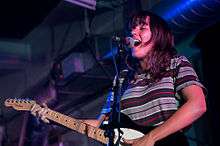
In 2005, The Seattle Times made note of grunge-influenced groups returning in the Seattle scene.[134] Similarly, The Guardian reported of grunge-influenced groups from Yorkshire, including Dinosaur Pile-Up, Pulled Apart by Horses, and Wonderswan.[135] Also, in 2003, the New York Times noted a resurgence in grunge fashion.[136]
The 2010s have birthed a number bands influenced by grunge. Unlike their forebears, some of these acts ascribe the label to themselves willingly. Many acts have been noted for affiliating and/or collaborating with prominent figures from the original alternative rock era. Steve Albini has produced for or worked with members of bands such as Bully,[137][138] Vomitface,[139][140][140] and Shannon Wright,[141] while Emma Ruth Rundle of Marriages[142] has toured with Buzz Osbourne of the Melvins. Other acts that have been labelled as grunge or as heavily influenced by the grunge era, include Courtney Barnett,[143][144] Wolf Alice,[145] Yuck,[146] Speedy Ortiz,[147] 2:54,[148] Baby in Vain,[149] Big Thief,[150] Dilly Dally,[151] Kagoule,[152] and Torres.[153]
Prominent grunge artists
Bands prominently labelled as grunge include:[97][154]
Seattle area
Outside the Seattle area
|